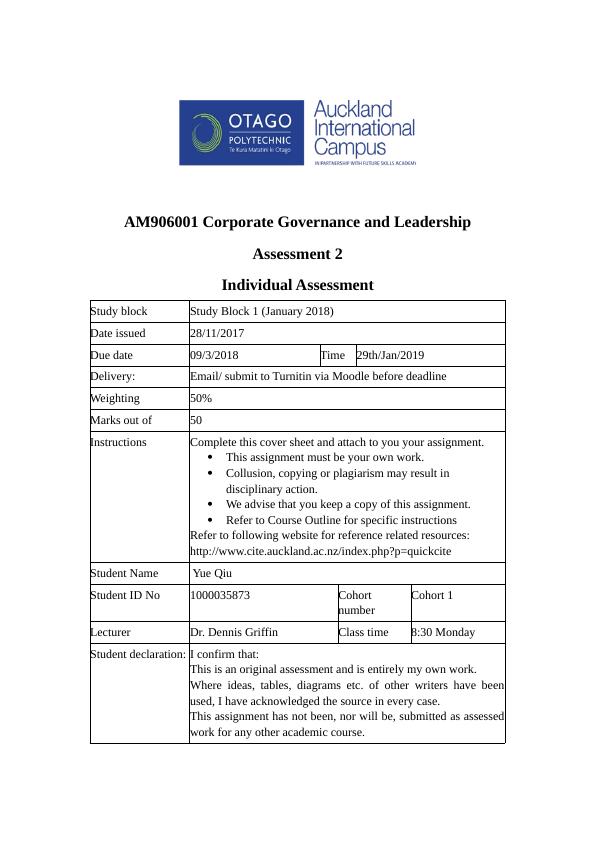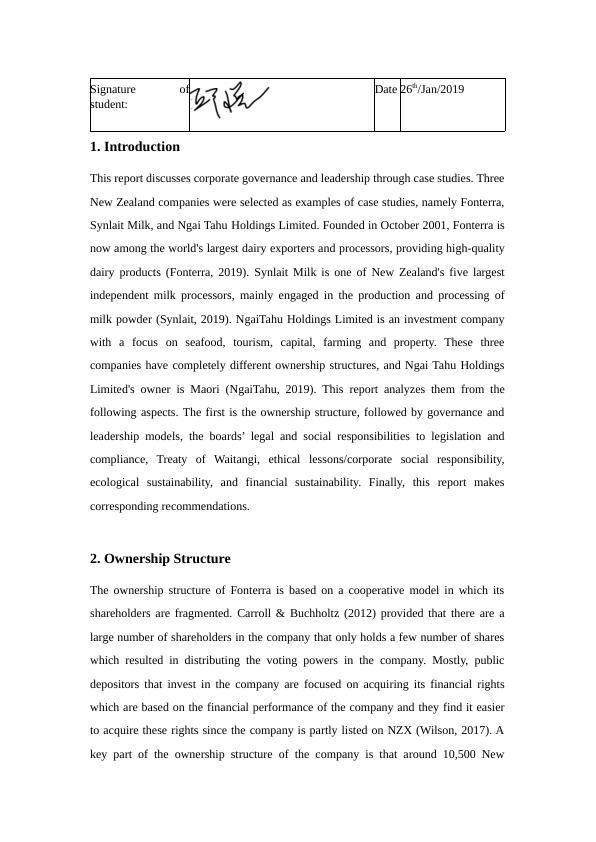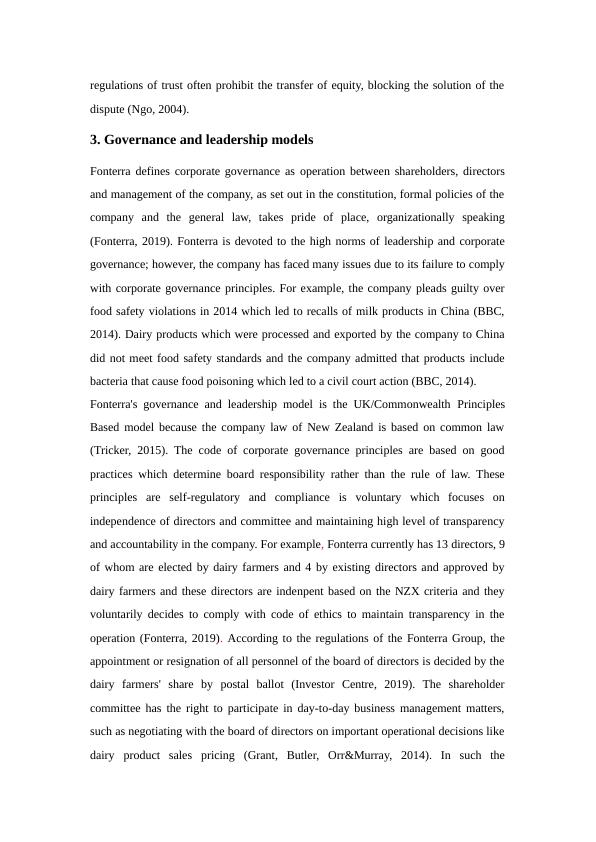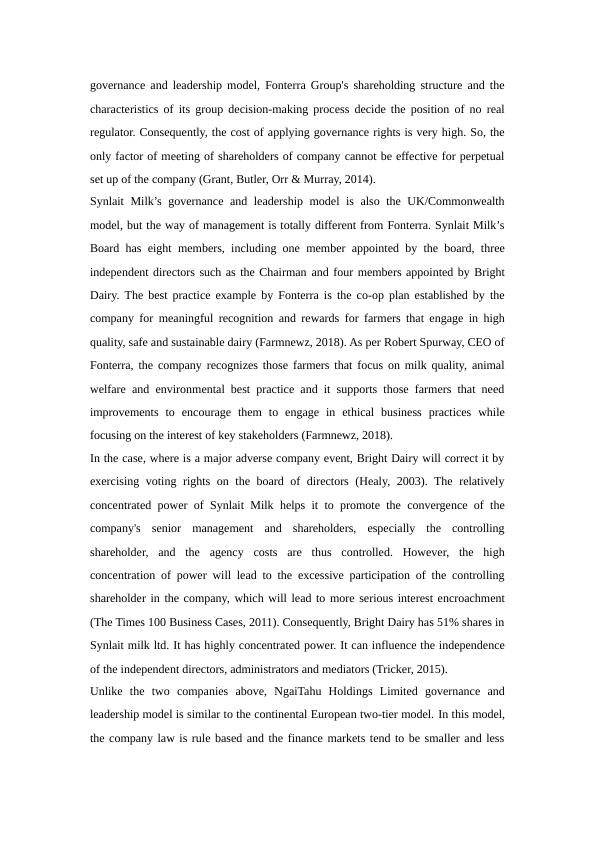Corporate Governance and Leadership: Case Studies of Fonterra, Synlait Milk, and Ngai Tahu Holdings Limited
Added on 2023-04-21
24 Pages8643 Words312 Views
AM906001 Corporate Governance and Leadership
Assessment 2
Individual Assessment
Study block Study Block 1 (January 2018)
Date issued 28/11/2017
Due date 09/3/2018 Time 29th/Jan/2019
Delivery: Email/ submit to Turnitin via Moodle before deadline
Weighting 50%
Marks out of 50
Instructions Complete this cover sheet and attach to you your assignment.
This assignment must be your own work.
Collusion, copying or plagiarism may result in
disciplinary action.
We advise that you keep a copy of this assignment.
Refer to Course Outline for specific instructions
Refer to following website for reference related resources:
http://www.cite.auckland.ac.nz/index.php?p=quickcite
Student Name Yue Qiu
Student ID No 1000035873 Cohort
number
Cohort 1
Lecturer Dr. Dennis Griffin Class time 8:30 Monday
Student declaration: I confirm that:
This is an original assessment and is entirely my own work.
Where ideas, tables, diagrams etc. of other writers have been
used, I have acknowledged the source in every case.
This assignment has not been, nor will be, submitted as assessed
work for any other academic course.
Assessment 2
Individual Assessment
Study block Study Block 1 (January 2018)
Date issued 28/11/2017
Due date 09/3/2018 Time 29th/Jan/2019
Delivery: Email/ submit to Turnitin via Moodle before deadline
Weighting 50%
Marks out of 50
Instructions Complete this cover sheet and attach to you your assignment.
This assignment must be your own work.
Collusion, copying or plagiarism may result in
disciplinary action.
We advise that you keep a copy of this assignment.
Refer to Course Outline for specific instructions
Refer to following website for reference related resources:
http://www.cite.auckland.ac.nz/index.php?p=quickcite
Student Name Yue Qiu
Student ID No 1000035873 Cohort
number
Cohort 1
Lecturer Dr. Dennis Griffin Class time 8:30 Monday
Student declaration: I confirm that:
This is an original assessment and is entirely my own work.
Where ideas, tables, diagrams etc. of other writers have been
used, I have acknowledged the source in every case.
This assignment has not been, nor will be, submitted as assessed
work for any other academic course.

Signature of
student:
Date 26th/Jan/2019
1. Introduction
This report discusses corporate governance and leadership through case studies. Three
New Zealand companies were selected as examples of case studies, namely Fonterra,
Synlait Milk, and Ngai Tahu Holdings Limited. Founded in October 2001, Fonterra is
now among the world's largest dairy exporters and processors, providing high-quality
dairy products (Fonterra, 2019). Synlait Milk is one of New Zealand's five largest
independent milk processors, mainly engaged in the production and processing of
milk powder (Synlait, 2019). NgaiTahu Holdings Limited is an investment company
with a focus on seafood, tourism, capital, farming and property. These three
companies have completely different ownership structures, and Ngai Tahu Holdings
Limited's owner is Maori (NgaiTahu, 2019). This report analyzes them from the
following aspects. The first is the ownership structure, followed by governance and
leadership models, the boards’ legal and social responsibilities to legislation and
compliance, Treaty of Waitangi, ethical lessons/corporate social responsibility,
ecological sustainability, and financial sustainability. Finally, this report makes
corresponding recommendations.
2. Ownership Structure
The ownership structure of Fonterra is based on a cooperative model in which its
shareholders are fragmented. Carroll & Buchholtz (2012) provided that there are a
large number of shareholders in the company that only holds a few number of shares
which resulted in distributing the voting powers in the company. Mostly, public
depositors that invest in the company are focused on acquiring its financial rights
which are based on the financial performance of the company and they find it easier
to acquire these rights since the company is partly listed on NZX (Wilson, 2017). A
key part of the ownership structure of the company is that around 10,500 New
student:
Date 26th/Jan/2019
1. Introduction
This report discusses corporate governance and leadership through case studies. Three
New Zealand companies were selected as examples of case studies, namely Fonterra,
Synlait Milk, and Ngai Tahu Holdings Limited. Founded in October 2001, Fonterra is
now among the world's largest dairy exporters and processors, providing high-quality
dairy products (Fonterra, 2019). Synlait Milk is one of New Zealand's five largest
independent milk processors, mainly engaged in the production and processing of
milk powder (Synlait, 2019). NgaiTahu Holdings Limited is an investment company
with a focus on seafood, tourism, capital, farming and property. These three
companies have completely different ownership structures, and Ngai Tahu Holdings
Limited's owner is Maori (NgaiTahu, 2019). This report analyzes them from the
following aspects. The first is the ownership structure, followed by governance and
leadership models, the boards’ legal and social responsibilities to legislation and
compliance, Treaty of Waitangi, ethical lessons/corporate social responsibility,
ecological sustainability, and financial sustainability. Finally, this report makes
corresponding recommendations.
2. Ownership Structure
The ownership structure of Fonterra is based on a cooperative model in which its
shareholders are fragmented. Carroll & Buchholtz (2012) provided that there are a
large number of shareholders in the company that only holds a few number of shares
which resulted in distributing the voting powers in the company. Mostly, public
depositors that invest in the company are focused on acquiring its financial rights
which are based on the financial performance of the company and they find it easier
to acquire these rights since the company is partly listed on NZX (Wilson, 2017). A
key part of the ownership structure of the company is that around 10,500 New

Zealand dairy farmers own the shareholders of the company; however, the
shareholding ratio of each member is less than one percent (Farrar, 2001). Since most
members of the company are farmers, they enjoy 100 percent holding of the company.
Due to this membership structure, if a person wants to purchase milk from the
company, then the transaction can only be completed after negotiation with the
corporation rather than the farmers themselves (Wilson, 2017). Barry, Lepitit & Tarazi
(2011) provided that due to this structure, the negotiating power of purchaser is
decreased which enables the company to enjoy control over the pricing strategy and
supply of its products. Moreover, this structure protects the interest of individual
farmers since they are able to establish a perfect quality traceability mechanism
(Painter, 2010). However, this structure has made it challenging for Fonterra to find
suitable and innovation structure by generating external capital since its operations are
limited to its shareholders and it cannot rely on external sources of funding (Hanson,
Dowling, Hitt, Ireland & Hoskisson, 2014).
However, ownership structure of Synlait Milk’s different that of Fonterra, which sole
proprietorship is. The ownership of the company is mainly divided into Synlait Milk’s
top three shareholders which include Bright Dairy, A2 Milk Company and Mitsui &
Co. Ltd., with the share percentage of 39.04%, 9.11%, and 8.38%, respectively
(Synlait,2019). The ownership of Bright Dairy in the company is unique because the
company became the owner of Synlait Milk on October 26, 2010 with a 51% stake in
Synlait Milk Limited (Synlait, 2019). Bright Dairy had made payment of eighty two
million dollars for having the fifty one per cent stakes in the marketing and processing
assets of private Canterbury processor that means top three biggest dairy entities of
the nation will be majorly and expressively foreign owned (Ugwu, Onyishi &
Rodríguezsánchez, 2014). The ownership structure of Synlait is different from the
cooperative model of Fonterra that shows the interests of various shareholders
whereas Bright Dairy is the only shareholder which has a major interest in Synlait.
In order to protect the ownership interest of farmers, the government of New Zealand
has provided that the stakes in the company which is acquired by Bright Dairy did not
shareholding ratio of each member is less than one percent (Farrar, 2001). Since most
members of the company are farmers, they enjoy 100 percent holding of the company.
Due to this membership structure, if a person wants to purchase milk from the
company, then the transaction can only be completed after negotiation with the
corporation rather than the farmers themselves (Wilson, 2017). Barry, Lepitit & Tarazi
(2011) provided that due to this structure, the negotiating power of purchaser is
decreased which enables the company to enjoy control over the pricing strategy and
supply of its products. Moreover, this structure protects the interest of individual
farmers since they are able to establish a perfect quality traceability mechanism
(Painter, 2010). However, this structure has made it challenging for Fonterra to find
suitable and innovation structure by generating external capital since its operations are
limited to its shareholders and it cannot rely on external sources of funding (Hanson,
Dowling, Hitt, Ireland & Hoskisson, 2014).
However, ownership structure of Synlait Milk’s different that of Fonterra, which sole
proprietorship is. The ownership of the company is mainly divided into Synlait Milk’s
top three shareholders which include Bright Dairy, A2 Milk Company and Mitsui &
Co. Ltd., with the share percentage of 39.04%, 9.11%, and 8.38%, respectively
(Synlait,2019). The ownership of Bright Dairy in the company is unique because the
company became the owner of Synlait Milk on October 26, 2010 with a 51% stake in
Synlait Milk Limited (Synlait, 2019). Bright Dairy had made payment of eighty two
million dollars for having the fifty one per cent stakes in the marketing and processing
assets of private Canterbury processor that means top three biggest dairy entities of
the nation will be majorly and expressively foreign owned (Ugwu, Onyishi &
Rodríguezsánchez, 2014). The ownership structure of Synlait is different from the
cooperative model of Fonterra that shows the interests of various shareholders
whereas Bright Dairy is the only shareholder which has a major interest in Synlait.
In order to protect the ownership interest of farmers, the government of New Zealand
has provided that the stakes in the company which is acquired by Bright Dairy did not

include the farmland assets (Pooch, 2008). Synlait takes approximately twenty per
cent of the milk from Fonterra, the regulatory requirement of Dairy Industry
Restructuring Act, and new ranchers had already come up to this entity that must
decrease the dependence on Fonterra milk to approximately ten per cent while the
new drier was constructed. In fact, the New Zealand government is more supportive
of overseas investments that do not harm their basic interests. Although, the
acquisition is only the factory, the farm is 100% owned by the previous shareholder of
Synlait Milk (Lee, 2004), so the milk source of the farm will still be 100% supplied to
SynlaitMilk which defines the ownership structure of the company.
Ngai Tahu yearly gives contribution in excess of two hundred million dollars to an
economy of South Island (NgaiTahu, 2019). Ngai Tahu has involved in present day
trading activities since year 1950, while the Ngai Tahu Maori Trust Board had per
annum income of approximately twenty thousand dollar to put to asset and
distribution by the iwi (NgaiTahu, 2019). Ngai Tahu used the earning to invest again
and raise the base of assets. From the starting, the financial policy of Ngai Tahu
included reinvesting unevenly two third of earning and upholding the firmly made
focus on distribution policy to render help to tribal members with the help
ofscholarship and educational grant (Painter, 2010). Ownership structure of NgaiTahu
Holdings Limited is unlike the above two companies, and it is controlled and operated
by the NgaiTahu Charitable Trust. According to the characteristics of the trust,
NgaiTahu Charitable Trust can invest in both the capital market and the industrial
sector, while Synlait Milk and Fonterra may face difficulties in doing the same thing
because of industry restrictions (Ugwu, Onyishi & Rodríguezsánchez, 2014). In order
to maximize the return of investors, NgaiTahu Holdings Limited achieves the
diversification of investment fields so that it can, to a certain extent, effectively reduce
investment risks (NgaiTahu, 2019). However, some rules of trust may block the way
out of the beneficiary dispute (Cant, 2010). When the beneficiaries have an equity
dispute, Synlait Milk and Fonterra can solve it through transfer of equity (Ugwu,
Onyishi&Rodríguezsánchez, 2014), but for NgaiTahu Holdings Limited, the
cent of the milk from Fonterra, the regulatory requirement of Dairy Industry
Restructuring Act, and new ranchers had already come up to this entity that must
decrease the dependence on Fonterra milk to approximately ten per cent while the
new drier was constructed. In fact, the New Zealand government is more supportive
of overseas investments that do not harm their basic interests. Although, the
acquisition is only the factory, the farm is 100% owned by the previous shareholder of
Synlait Milk (Lee, 2004), so the milk source of the farm will still be 100% supplied to
SynlaitMilk which defines the ownership structure of the company.
Ngai Tahu yearly gives contribution in excess of two hundred million dollars to an
economy of South Island (NgaiTahu, 2019). Ngai Tahu has involved in present day
trading activities since year 1950, while the Ngai Tahu Maori Trust Board had per
annum income of approximately twenty thousand dollar to put to asset and
distribution by the iwi (NgaiTahu, 2019). Ngai Tahu used the earning to invest again
and raise the base of assets. From the starting, the financial policy of Ngai Tahu
included reinvesting unevenly two third of earning and upholding the firmly made
focus on distribution policy to render help to tribal members with the help
ofscholarship and educational grant (Painter, 2010). Ownership structure of NgaiTahu
Holdings Limited is unlike the above two companies, and it is controlled and operated
by the NgaiTahu Charitable Trust. According to the characteristics of the trust,
NgaiTahu Charitable Trust can invest in both the capital market and the industrial
sector, while Synlait Milk and Fonterra may face difficulties in doing the same thing
because of industry restrictions (Ugwu, Onyishi & Rodríguezsánchez, 2014). In order
to maximize the return of investors, NgaiTahu Holdings Limited achieves the
diversification of investment fields so that it can, to a certain extent, effectively reduce
investment risks (NgaiTahu, 2019). However, some rules of trust may block the way
out of the beneficiary dispute (Cant, 2010). When the beneficiaries have an equity
dispute, Synlait Milk and Fonterra can solve it through transfer of equity (Ugwu,
Onyishi&Rodríguezsánchez, 2014), but for NgaiTahu Holdings Limited, the

regulations of trust often prohibit the transfer of equity, blocking the solution of the
dispute (Ngo, 2004).
3. Governance and leadership models
Fonterra defines corporate governance as operation between shareholders, directors
and management of the company, as set out in the constitution, formal policies of the
company and the general law, takes pride of place, organizationally speaking
(Fonterra, 2019). Fonterra is devoted to the high norms of leadership and corporate
governance; however, the company has faced many issues due to its failure to comply
with corporate governance principles. For example, the company pleads guilty over
food safety violations in 2014 which led to recalls of milk products in China (BBC,
2014). Dairy products which were processed and exported by the company to China
did not meet food safety standards and the company admitted that products include
bacteria that cause food poisoning which led to a civil court action (BBC, 2014).
Fonterra's governance and leadership model is the UK/Commonwealth Principles
Based model because the company law of New Zealand is based on common law
(Tricker, 2015). The code of corporate governance principles are based on good
practices which determine board responsibility rather than the rule of law. These
principles are self-regulatory and compliance is voluntary which focuses on
independence of directors and committee and maintaining high level of transparency
and accountability in the company. For example, Fonterra currently has 13 directors, 9
of whom are elected by dairy farmers and 4 by existing directors and approved by
dairy farmers and these directors are indenpent based on the NZX criteria and they
voluntarily decides to comply with code of ethics to maintain transparency in the
operation (Fonterra, 2019). According to the regulations of the Fonterra Group, the
appointment or resignation of all personnel of the board of directors is decided by the
dairy farmers' share by postal ballot (Investor Centre, 2019). The shareholder
committee has the right to participate in day-to-day business management matters,
such as negotiating with the board of directors on important operational decisions like
dairy product sales pricing (Grant, Butler, Orr&Murray, 2014). In such the
dispute (Ngo, 2004).
3. Governance and leadership models
Fonterra defines corporate governance as operation between shareholders, directors
and management of the company, as set out in the constitution, formal policies of the
company and the general law, takes pride of place, organizationally speaking
(Fonterra, 2019). Fonterra is devoted to the high norms of leadership and corporate
governance; however, the company has faced many issues due to its failure to comply
with corporate governance principles. For example, the company pleads guilty over
food safety violations in 2014 which led to recalls of milk products in China (BBC,
2014). Dairy products which were processed and exported by the company to China
did not meet food safety standards and the company admitted that products include
bacteria that cause food poisoning which led to a civil court action (BBC, 2014).
Fonterra's governance and leadership model is the UK/Commonwealth Principles
Based model because the company law of New Zealand is based on common law
(Tricker, 2015). The code of corporate governance principles are based on good
practices which determine board responsibility rather than the rule of law. These
principles are self-regulatory and compliance is voluntary which focuses on
independence of directors and committee and maintaining high level of transparency
and accountability in the company. For example, Fonterra currently has 13 directors, 9
of whom are elected by dairy farmers and 4 by existing directors and approved by
dairy farmers and these directors are indenpent based on the NZX criteria and they
voluntarily decides to comply with code of ethics to maintain transparency in the
operation (Fonterra, 2019). According to the regulations of the Fonterra Group, the
appointment or resignation of all personnel of the board of directors is decided by the
dairy farmers' share by postal ballot (Investor Centre, 2019). The shareholder
committee has the right to participate in day-to-day business management matters,
such as negotiating with the board of directors on important operational decisions like
dairy product sales pricing (Grant, Butler, Orr&Murray, 2014). In such the

governance and leadership model, Fonterra Group's shareholding structure and the
characteristics of its group decision-making process decide the position of no real
regulator. Consequently, the cost of applying governance rights is very high. So, the
only factor of meeting of shareholders of company cannot be effective for perpetual
set up of the company (Grant, Butler, Orr & Murray, 2014).
Synlait Milk’s governance and leadership model is also the UK/Commonwealth
model, but the way of management is totally different from Fonterra. Synlait Milk’s
Board has eight members, including one member appointed by the board, three
independent directors such as the Chairman and four members appointed by Bright
Dairy. The best practice example by Fonterra is the co-op plan established by the
company for meaningful recognition and rewards for farmers that engage in high
quality, safe and sustainable dairy (Farmnewz, 2018). As per Robert Spurway, CEO of
Fonterra, the company recognizes those farmers that focus on milk quality, animal
welfare and environmental best practice and it supports those farmers that need
improvements to encourage them to engage in ethical business practices while
focusing on the interest of key stakeholders (Farmnewz, 2018).
In the case, where is a major adverse company event, Bright Dairy will correct it by
exercising voting rights on the board of directors (Healy, 2003). The relatively
concentrated power of Synlait Milk helps it to promote the convergence of the
company's senior management and shareholders, especially the controlling
shareholder, and the agency costs are thus controlled. However, the high
concentration of power will lead to the excessive participation of the controlling
shareholder in the company, which will lead to more serious interest encroachment
(The Times 100 Business Cases, 2011). Consequently, Bright Dairy has 51% shares in
Synlait milk ltd. It has highly concentrated power. It can influence the independence
of the independent directors, administrators and mediators (Tricker, 2015).
Unlike the two companies above, NgaiTahu Holdings Limited governance and
leadership model is similar to the continental European two-tier model. In this model,
the company law is rule based and the finance markets tend to be smaller and less
characteristics of its group decision-making process decide the position of no real
regulator. Consequently, the cost of applying governance rights is very high. So, the
only factor of meeting of shareholders of company cannot be effective for perpetual
set up of the company (Grant, Butler, Orr & Murray, 2014).
Synlait Milk’s governance and leadership model is also the UK/Commonwealth
model, but the way of management is totally different from Fonterra. Synlait Milk’s
Board has eight members, including one member appointed by the board, three
independent directors such as the Chairman and four members appointed by Bright
Dairy. The best practice example by Fonterra is the co-op plan established by the
company for meaningful recognition and rewards for farmers that engage in high
quality, safe and sustainable dairy (Farmnewz, 2018). As per Robert Spurway, CEO of
Fonterra, the company recognizes those farmers that focus on milk quality, animal
welfare and environmental best practice and it supports those farmers that need
improvements to encourage them to engage in ethical business practices while
focusing on the interest of key stakeholders (Farmnewz, 2018).
In the case, where is a major adverse company event, Bright Dairy will correct it by
exercising voting rights on the board of directors (Healy, 2003). The relatively
concentrated power of Synlait Milk helps it to promote the convergence of the
company's senior management and shareholders, especially the controlling
shareholder, and the agency costs are thus controlled. However, the high
concentration of power will lead to the excessive participation of the controlling
shareholder in the company, which will lead to more serious interest encroachment
(The Times 100 Business Cases, 2011). Consequently, Bright Dairy has 51% shares in
Synlait milk ltd. It has highly concentrated power. It can influence the independence
of the independent directors, administrators and mediators (Tricker, 2015).
Unlike the two companies above, NgaiTahu Holdings Limited governance and
leadership model is similar to the continental European two-tier model. In this model,
the company law is rule based and the finance markets tend to be smaller and less

End of preview
Want to access all the pages? Upload your documents or become a member.
Related Documents
Corporate Governance and Leadership: Case Studies of Fonterra, Synlait Milk, and Ngai Tahu Holdings Limitedlg...
|27
|9717
|406
Corporate Governance: Ownership Structures and Board Modelslg...
|31
|5971
|172
